Intel Alder Lake-H Core i9-12900HK Review: MSI's Raider GE76 Goes Hybrid
by Brett Howse on January 25, 2022 9:00 AM EST- Posted in
- CPUs
- Intel
- MSI
- Laptops
- Alder Lake
- GE76 Raider
- 12th Gen Core
- Alder Lake-H
System Performance: Hybrid CPU Design
With the new hybrid CPU design available in Alder Lake there are now 20 threads available. The system features six P-Core, and each P-Core offers simultaneous multithreading with two threads per core, meaning there are twelve threads available on the P-Cores. The E-Cores are single-threaded only, and there are eight E-Cores. The new Thread Director from Intel coupled with Windows 11’s thread scheduler is aware of the cores being high-performance and low-performance and will tend to assign work accordingly; but if the system is not busy and the workload is in the foreground and multi-threaded, it will schedule threads across all 20 cores if needed. If an active task is moved to the background by the user, by either minimizing the task or opening another workload, the background task is allocated to the E-Cores and the P-Cores are prioritized for user-focused work.
This means that even on a heavily loaded system, system responsiveness should be maintained, and although the user will not have their full system performance available, the P-Cores will be prioritized for active workloads instead of background tasks. For our standard performance testing, benchmarks are always run as the only active task so that the results are representative, but for this review we will also cover some multi-tasking scenarios in a bit.
To test system performance, the system was set to dedicated graphics mode since this is the way most Desktop Replacement systems will be run, and the MSI laptop was set to its maximum performance setting.
PCMark 10

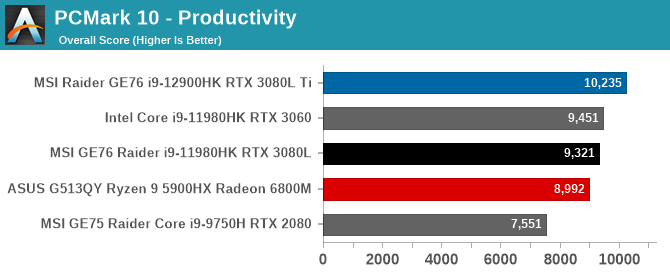
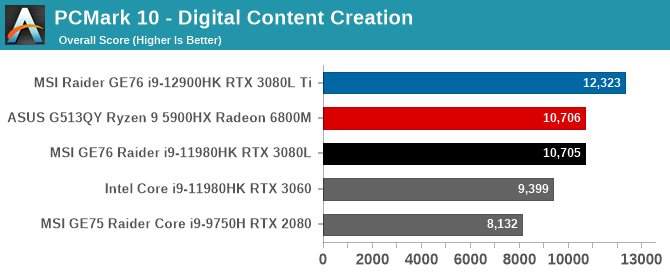
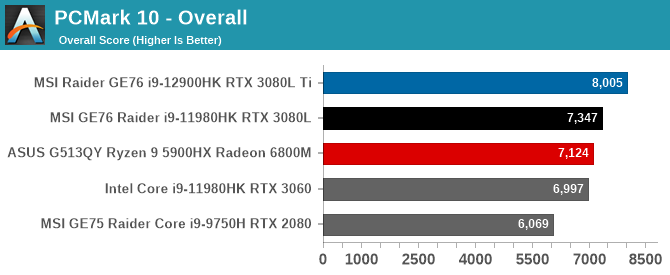
UL’s PCMark is a full-system benchmark which not only measures CPU performance, but also memory, storage, and graphics. It is being included as a reference since we always include it in laptop reviews, but be aware that the MSI Raider GE76 now offers the RTX 3080L Ti GPU, which is a step above the RTX 3080L found in the 2021 MSI GE76 Raider. As with all laptop testing, it is almost impossible to have a completely apples to apples comparison. The Raider GE76 also ships with much faster DDR5-4800 memory, an advantage of the Alder Lake platform.
That being said, the new Alder Lake system is by far the quickest notebook we have ever tested on PCMark 10. Some of that is CPU, and some is GPU, and some is memory, and some is storage. As was said at the start, Intel is putting their best foot forward, and it is hard to blame them.
Cinebench R20
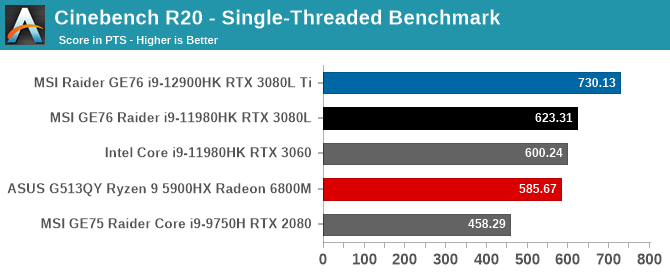
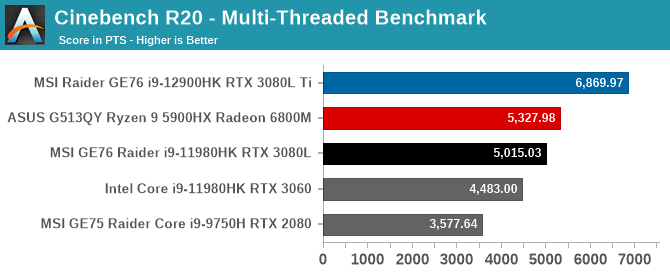
Always a popular benchmark due to its ease of use and ability to set the test to be single-threaded or multi-threaded, Cinebench is more of a pure CPU test since it does not leverage the GPU at all and is not very memory intensive.
Tiger Lake had a small single-threaded performance lead over the latest Ryzen processors, and Alder Lake simply smashes both of them. The single-threaded performance uplift is seriously impressive.
On the multi-threaded side, AMD’s better power efficiency with Ryzen allowed them to pull ahead in the past, but now that Alder Lake features 20 threads compared to 16 in the Ryzen 9 5900HX, the Core i9-12900HK pulls well in front with all threads loaded. This is despite it having only twelve threads of performance cores, so the eight E-Cores are definitely pulling their weight here.
Handbrake

Probably the most popular transcoding tool around, Handbrake has support for software-based transcoding as well has hardware-based with support for AMD’s VCE, NVIDIA’s NVENC and Intel QuickSync. We test by doing a transcode of a 1080p Blu-Ray rip to 720p with the same quality settings for all encoders. For most transcoding, software transcoding tends to yield the best quality, however the specialty hardware can often complete the task in less time.
As a heavily multithreaded task, AMD’s Cezanne platform was our previous champ here, but Alder Lake demolishes the previous results. The new Golden Cove / Gracemont combination offers an almost 30% uptick compared to Tiger Lake in the same chassis. If you peek down to the Hardware transcode graph, you will see that the new Alder Lake platform is actually quicker at this particular test than the QuickSync was on Tiger Lake. Very impressive.
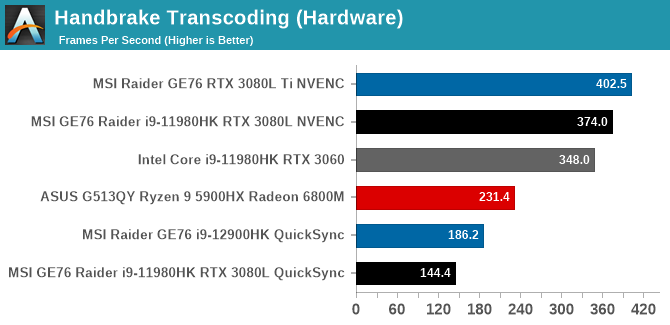
Speaking of hardware transcoding, Intel’s QuickSync does get a bump over Tiger Lake’s implementation, but perhaps unsurprisingly they are smashed by the NVIDIA encoders in the big graphics cards installed in the MSI Raider systems.
7-Zip
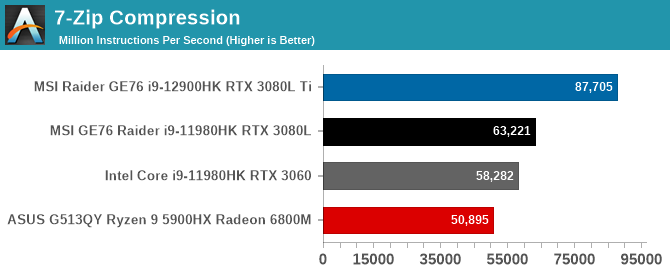
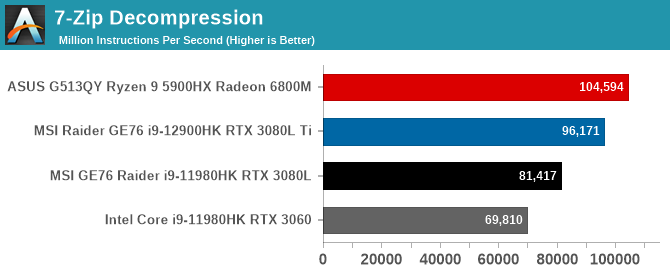
Despite a massive uplift in compression speed in the Core i9-12900HK, Intel isn’t quite able to wrestle the decompression crown away from AMD’s Ryzen 9 5900HX, although it is much, much closer than it was before.
Web Tests
Although web performance is an integral part of most people’s lives now, testing web performance is both testing the CPU performance as well as the browser’s scripting engine. As such, to be as consistent as possible, all web benchmarks are run on the current version of Microsoft Edge, which is based on the Chromium web browser. However, updates to the browser which happen very frequently could impact performance, so any results we have in our database are snapshots from the time that laptop was reviewed. For now, with the decommissioning of several popular browser benchmarks, we are focusing on Speedometer 2.0 from Webkit, and WebXPRT 3 from Principled Technologies. WebXPRT 4 is in preview now, and once it launches, we will take a look at it for future reviews.
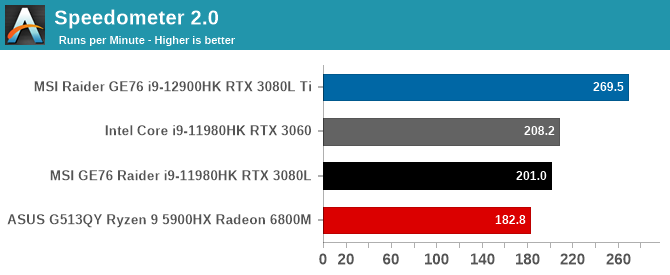
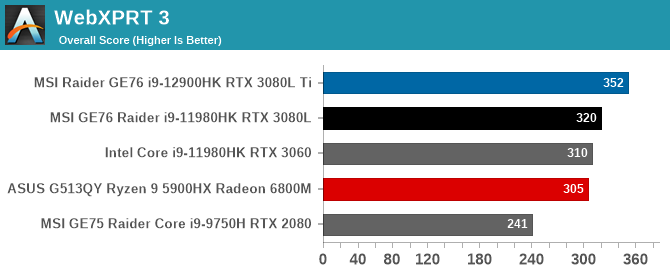
Web performance is often dependent on single-threaded performance, as well as how quickly a processor can ramp up to maximum performance. Both AMD and Intel have made big improvements in how quickly their processors can boost to their maximum frequency, as well as how many steps there are on the way.
With Intel’s hefty increase in single-threaded performance with the Golden Cove CPU architecture it should be no surprise to see them at the top. How far they are in front though is very impressive.
System Performance Summary
Wow is a good word to summarize. Intel’s newest Alder Lake with its new hybrid design, featuring both Golden Cove and Gracemont CPU cores, delivers a substantial increase in performance over their outgoing Tiger Lake platform. With six P-Cores and eight E-Cores, the new Core i9-12900HK offers an impressive twenty threads. With dissimilar performance of the threads, extra legwork was needed to be done to correctly distribute workloads to the right cores, but Intel has done that with their Thread Director system which is integrated into Windows 11.
Intel has squarely thrown the ball back into AMD’s court. Intel now lead in CPU performance by a substantial margin, and Intel’s Iris Xe graphics also delivers more performance than the current Vega GPU in Ryzen 5000. This is a potent combination.


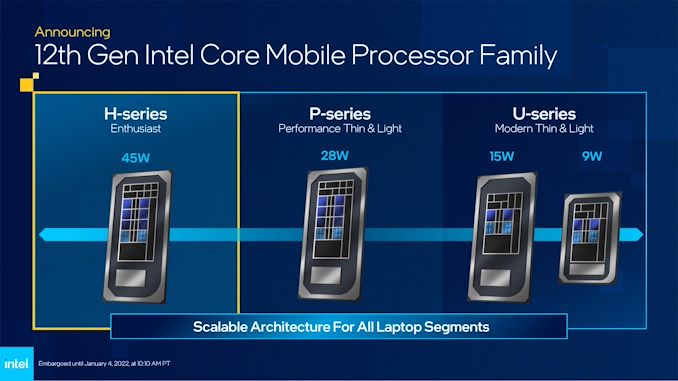








153 Comments
View All Comments
soloracerx - Tuesday, January 25, 2022 - link
NewEgg just put up the pre-orders today for the MSI line 12th gen lappys. Staggered release from Feb through April. The one reviewed here will be available 3/28/22 for $4199. https://www.newegg.com/p/pl?d=12th+gen+laptopmabellon - Tuesday, January 25, 2022 - link
“The new Alder Lake system could only average 83% of its original frames per second, because that task was deprioritized by Thread Director to free up additional resources for the foreground jobs.”Foreground and background detection is provided by the OS. The CPU alone has no way to identify which threads are rendering on screen, the OS and window management tracking is responsible. This window tracking, and more, are critical for hybrid scheduling, favored core scheduling, etc. Https://docs.microsoft.com/en-us/windows/win32/procthread/quality-of-service
If you want to test Thread Director you need to test workloads with multiple concurrent workload classifications by Thread Director. A complex workload (or multiple concurrent workloads) with different thread execution (I.e. some AVX, some not). For example, if you have two on-screen workloads (I.e. both prefer performance), but there are more concurrent workload threads to schedule than there are P-Cores, which subset of those threads will get the most performance out of the limited set of P-Cores?Homogenous workloads where all threads are roughly equivalent and running the same instruction mix are unlikely to have much impact (e.g. Cinebench, Handbrake). Workloads that fit entirely on P-Cores are unlikely to have much impact as there is no overflow to E-cores.
Another alternative would be if a particular workload classification was inverted versus the norm. For example, normally one would expect E-cores to be the most efficient. On a laptop you might want background services and apps scheduled to the most efficient cores for battery life. But what if the workload running happens to heavily exercise instructions that are actually more efficient to run on P-cores?
Those are some examples of how Thread Director plays a role.
kenansadhu - Thursday, January 27, 2022 - link
Will it be where the AMD's design win out? Because there wouldn't be any risk for the user of any OS or scheduler's mistake (since all cores are the same).Da W - Tuesday, January 25, 2022 - link
I remember back in the days when AMD GPU was beating NVIdia but with 50 watt more power draw, they were discarded as crap!How things change. Wattage does not seem to matter anymore.
Calin - Wednesday, January 26, 2022 - link
I chose nVidia because I didn't had a PCI-E power cable (or the wattage). At roughly similar price and performance, AMD broke the 75W limit and nVidia didn't.With processors already installed in systems, the equation changes a bit - you can still get the performance, at a lower battery life.
Spunjji - Thursday, January 27, 2022 - link
Generally speaking, you can assume that watts are important when AMD draw more of them; not so much when Intel or Nvidia draw more and win.TheinsanegamerN - Friday, January 28, 2022 - link
Nobody disregarded AMD's hawaii GPUs for pulling more power, tech media was singing their praises from every rooftop.They slammed the 390x for being just a rebranded 290x that drew even more power but couldnt keep up with nvidia's high end.
But context is the enemy of the fanboi.
BillBear - Tuesday, January 25, 2022 - link
You guys really need to start posting performance numbers when the laptop is unplugged, now that power draw figures have become so ridiculous that laptops immediately have to throttle down when unplugged.TekCheck - Tuesday, January 25, 2022 - link
Benchamark tech-tubers and tech website should follow Anandtech's practice and start publishing performance+power benchmarks for laptops, to give us better context behind high bars in any test. This is less important for desktops, but as laptops are usually portable devices, it is paramount that we know the power behind performance.If 12900HK is winning in any bars, say 20% over 6900HX, we need to know at which power level. Is it at 45W? At 60W? At 115W? If the win is at high wattage only, users will have a wrong impression that such CPU has "better" performance, which is untrue without knowing the power needed for such performance.
Brett Howse - Tuesday, January 25, 2022 - link
Mentioned this in the review. The AMD 5900HX system also draws the same power at load.